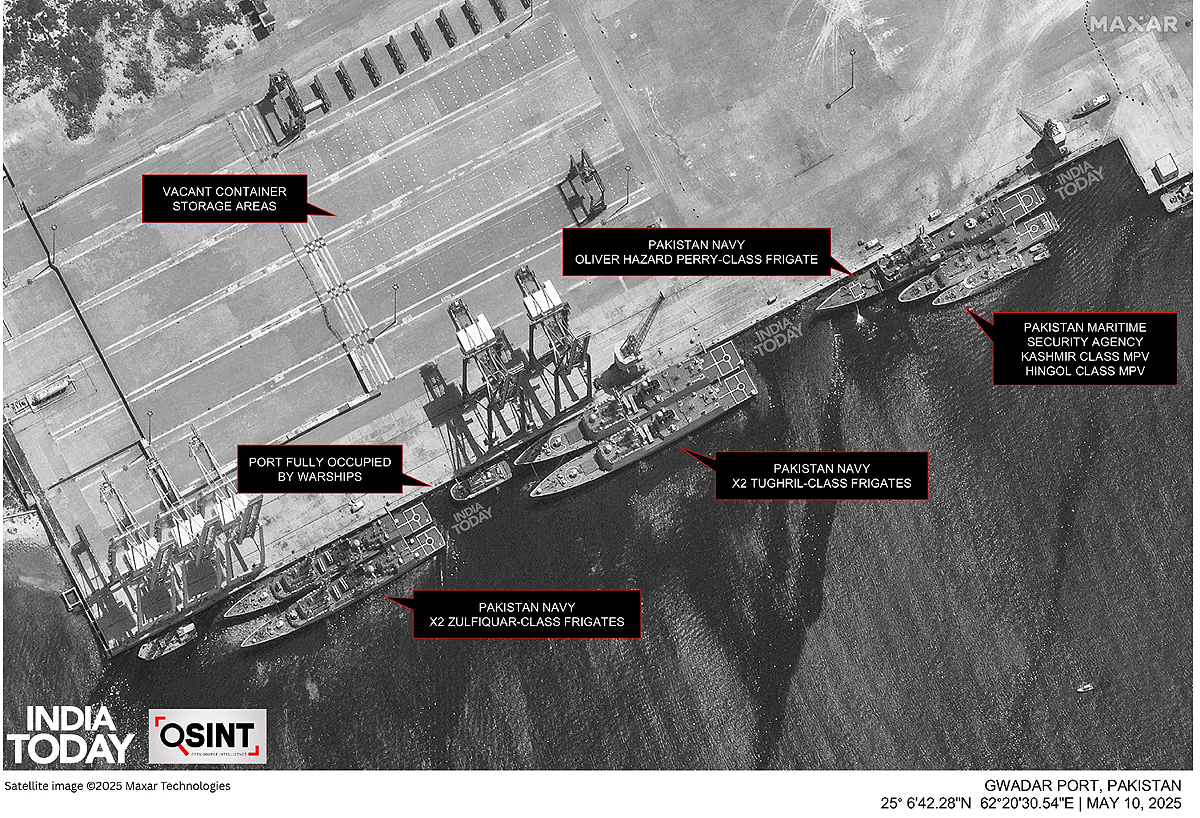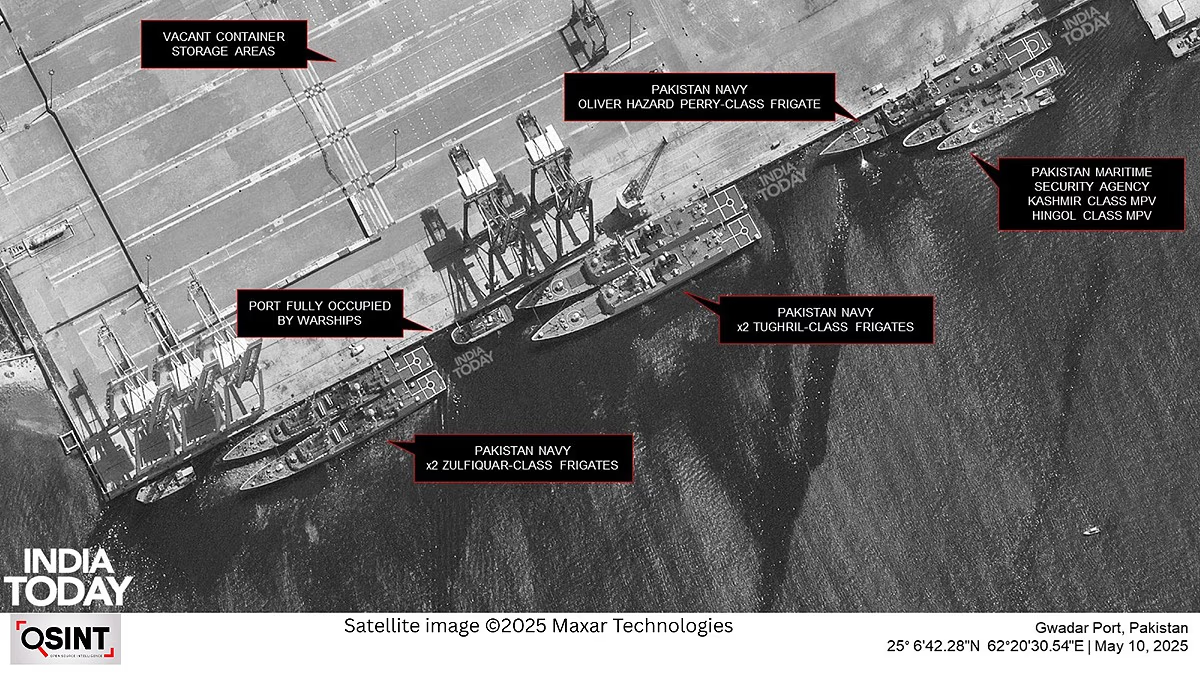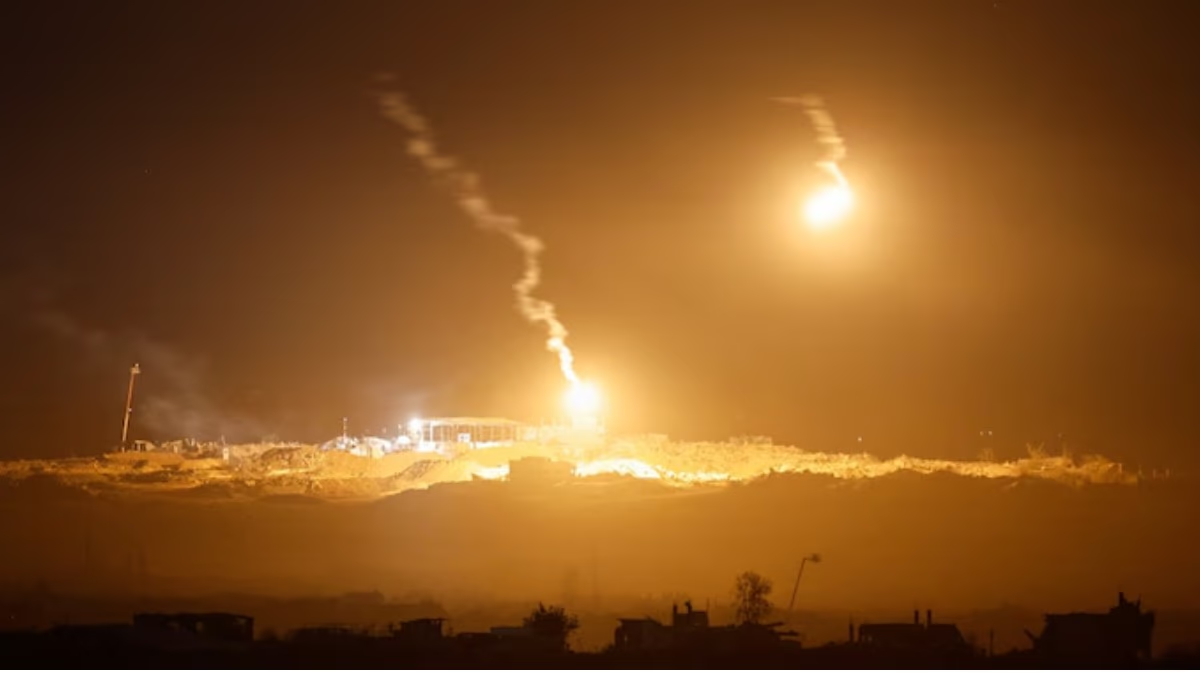On the nights of May 6 and 7, Indian strikes targeted nine terrorist locations in Pakistan and PoJK. Subsequently, New Delhi informed Islamabad’s Director General of Military Operations (DGMO) that the mission was accomplished. Despite Pakistan’s leadership mentioning severe counters, satellite images analyzed by India Today’s Open-Source Intelligence (OSINT) team from Karachi and Gwadar ports suggest a defensive stance by the Pakistan Navy during Operation Sindoor.
At the peak of the conflict, the Pakistan Navy (PN) warships were moved from Karachi’s naval dockyard to commercial terminals, as depicted in the satellite images. Meanwhile, other warships sought refuge at the western port of Gwadar, just 100 km from the Iran border, rather than heading east towards India.

Source: aajtak
Also read:
Top military experts have raised questions about Pakistan Navy’s preparedness during the tension. Retired Vice Admiral S.C. Suresh Bangara, former Commander-in-Chief of the Southern Naval Command and a veteran of the 1971 Karachi Port attack, pointed out that as our strike against terrorist infrastructure occurred on May 7, all three arms of the Pakistani military should have been on high alert. Yet, their frontline warships remained in port, indicating low operational readiness.
He further observed a pattern where Pakistani naval ships station at commercial terminals, taking cover under civilian flights during operations. Bringing them into a commercial port area appears to be an attempt to evade missile strikes. He told India Today that flying military aircraft close to commercial flights indicates a tendency to sacrifice civilian resources.
Also read:

Source: aajtak
Pakistani warships take refuge near Iran border
Just six months before Operation Sindoor, the Pakistan Navy claimed to have added a new weapon – the ‘indigenously developed’ P282 ship-launched ballistic missile. It had a reported range of 350 kilometers and promised ‘high precision’ strikes. A military promotional video showcased this, with a Chinese-made Zulfiquar-class (F-22P) frigate firing the missile.
However, when Operation Sindoor commenced in May 2025, it painted a different picture. High-resolution commercial images from space company Maxar Technologies revealed that half of its Zulfiquar-class frigates and other warships were stationed at Gwadar, just 100 kilometers from the Iran border.
Also read:
Gwadar Port, termed the jewel of the China-Pakistan Economic Corridor, was temporarily transformed into a naval refuge. During Operation Sindoor, satellite images showed its container yards empty by May 10, but the docks were crowded with military vessels. These included two Zulfiquar-class frigates, two large Tughril-class frigates, the navy’s only American-made Oliver Hazard Perry-class frigate, and two maritime patrol vessels.
Retired Vice Admiral Bangara remarked, "Stationing frontline ships at Gwadar, a location devoid of commercial activities, was flawed as they were easily visible. It suggests their only strength at sea was their submarines.
India's Strength and Pakistan's Pressure
Geoint researcher Damien Simon highlighted, "During Operation Sindoor, India’s first indigenous aircraft carrier INS Vikrant undertook its maiden combat deployment, showcasing its presence in the Arabian Sea to the Pakistan Navy, indicating New Delhi's pressure. Preparing for a potential strike on Karachi, Pakistan dispersed its navy and docked ships at civilian docks.
Also read:
Warships at Karachi’s Commercial Terminals
Earlier, Karachi’s naval dockyard was unusually empty, while satellite images from May 8 showed warships parked at commercial cargo terminals. In partially cloud-covered images, at least four Pakistani Navy (PN) ships were visible near commercial ports and container terminals. These included PNS Alamgir, a Babar-class corvette, and a Damen offshore patrol vessel (OPV), docked beside cargo ships where containers were being loaded and unloaded. Another naval frigate was stationed at a container terminal, not at a naval dockyard.
Bangara stated, "The Pakistani Navy has no significant role in the army-driven structures. India meticulously planned joint operations, achieving all objectives of Operation Sindoor. We established readiness for punitive counter-strikes without firing any missile from the sea. Our naval force's powerful strike could have devastated their maritime resources, just as the PAF air bases suffered on August 10. Joint operations conserve ammunition to prolong war. Remember, Operation Sindoor is just paused.
Gwadar's New Role
Simon noted the shift in Gwadar's use. "This pressure came as several vessels of Pakistan’s submarine branch were out for repairs, reducing maritime threat. Under this mounting pressure, Gwadar—a long-ailing commercial port—became a naval fallback base. With its 600-meter dock, warships and offshore tankers offered Islamabad a stronghold away from Karachi.
India's Preparations
The Indian Navy had previously declared readiness to strike Karachi if necessary. During a joint media briefing in May 2025, Vice Admiral A.N. Pramod stated that our forces were well-positioned in the Arabian Sea and fully prepared to attack Karachi at a chosen time, at sea and on land.




